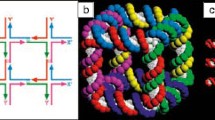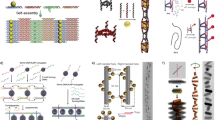Abstract
PATTERNING matter on the nanometre scale is an important objective of current materials chemistry and physics. It is driven by both the need to further miniaturize electronic components and the fact that at the nanometre scale, materials properties are strongly size-dependent and thus can be tuned sensitively1. In nanoscale crystals, quantum size effects and the large number of surface atoms influence the, chemical, electronic, magnetic and optical behaviour2—4. 'Top-down' (for example, lithographic) methods for nanoscale manipulation reach only to the upper end of the nanometre regime5; but whereas 'bottom-up' wet chemical techniques allow for the preparation of mono-disperse, defect-free crystallites just 1–10 nm in size6–10, ways to control the structure of nanocrystal assemblies are scarce. Here we describe a strategy for the synthesis of'nanocrystal molecules', in which discrete numbers of gold nanocrystals are organized into spatially defined structures based on Watson-Crick base-pairing interactions. We attach single-stranded DNA oligonucleotides of defined length and sequence to individual nanocrystals, and these assemble into dimers and trimers on addition of a complementary single-stranded DNA template. We anticipate that this approach should allow the construction of more complex two-and three-dimensional assemblies.
Similar content being viewed by others
References
Alivisatos, A. P. Science 271, 933–937 (1996).
Bawendi, M. G., Steigerwald, M. L. & Brus, L. E. Annu. Rev. Phys. Chem 41, 477–496 (1990).
Weller, H. Angew. Chem. Int. Edn. Engl. 32, 41–53 (1993).
Tolbert, S. H. & Alivisatos, A. P. Annu. Rev. Phys. Chem. 46, 595–625 (1995).
Waugh, F. R. et al. Phys. Rev. Lett. 75, 705–708 (1995).
Murray, C. B., Norris, D. J. & Bawendi, M. G. J. Am. Chem. Soc. 115, 8706–8715 (1993).
Littau, K. A., Szajowski, P. J., Muller, A. J., Kortan, A. R. & Brus, L. E. J. Phys. Chem. 97, 1224–1230 (1993).
Guzelian, A. A. et al. J. Phys. Chem. 100, 7212–7219 (1996).
Schmid, G. Chem. Rev. 92, 1709–1727 (1992).
Haneda, K. Can. J. Phys. 65, 1233–1241 (1987).
Spanhel, L., Weller, H. & Henglein, A. J. Am. Chem. Soc. 109, 6632–6635 (1987).
Gopidas, K. R., Bohorquez, M. & Kamat, P. V. J. Phys. Chem. 94, 6435–6440 (1990).
Brust, M., Bethell, D., Schiffrin, D. J. & Kiely, C. J. Adv. Mater. 7, 795–797 (1995).
Lawless, D., Kapoor, S. & Meisel, D. J. Phys. Chem. 99, 10329–10335 (1995).
Pag. X. et al. Angew. Chem. (submitted).
Peschel, S. & Schmid, G. Angew. Chem. Int. Edn. Engl. 34, 1442–1443 (1995).
Whetten, R. L. et al. Adv. Mater. 8, 428–433 (1996).
Andres, R. P. et al. Science 272, 1323–1325 (1996).
Klein, D. L., McEuen, P. L., Bowen-Katari, J. E., Roth, R., Alivisatos, A. P. Appl. Phys. Lett. 68, 2574–2576 (1996).
Covin, V. L., Goldstein, A. N., Alivisatos, A. P. J. Am. Chem. Soc. 114, 5221–5230 (1992).
Fendler, J. H., Meldrum, F. C. Adv. Mater. 7, 607–632 (1995).
Peng, X. et al. J. Phys. Chem. 96, 3412–3416 (1992).
Murray, C. B., Kagan, C. R. & Bawendi, M. G. Science 270, 1335–1338 (1995).
Vossmeyer, T. et al. Science 267, 1476–1479 (1995).
Herron, N., Calabrese, J. C., Farneth, W. E. & Wang, Y. Science 259, 1426–1428 (1993).
Bentzon, M. D., van Wonterghem, J., Morup, S., Tholen, A. & Koch, C. J. W. Phil. Mag. B 60, 169–178 (1989).
Seeman, N. C. Mater. Res. Soc. Symp. Proc. 292, 123–135 (1993).
Niemeyer, C. M., Sano, T., Smith, C. L. & Cantor, C. R. Nucleic. Acids Res. 22, 5530–5539 (1994).
Zuckermann, R. N., Corey, D. R. & Schultz, P. G. Nucleic. Acids Res. 15, 5305–5321 (1987).
Maniatis, T., Frisch, E. F. & Sambrook, J. Molecular Cloning: A Laboratory Manual (Cold Spring Harbor Lab., Cold Spring Harbor, NY, 1989).
Author information
Authors and Affiliations
Rights and permissions
About this article
Cite this article
Alivisatos, A., Johnsson, K., Peng, X. et al. Organization of 'nanocrystal molecules' using DNA. Nature 382, 609–611 (1996). https://doi.org/10.1038/382609a0
Received:
Accepted:
Issue Date:
DOI: https://doi.org/10.1038/382609a0
- Springer Nature Limited
This article is cited by
-
Printing with a quantum dot matrix
Nature Materials (2023)
-
Gold nanoparticle dimer–based immunochromatography for in situ ultrasensitive detection of porcine epidemic diarrhea virus
Microchimica Acta (2023)
-
Comprehensive view of microscopic interactions between DNA-coated colloids
Nature Communications (2022)
-
Multiscale hierarchical structures from a nanocluster mesophase
Nature Materials (2022)
-
Self-assembled inorganic chiral superstructures
Nature Reviews Chemistry (2022)





